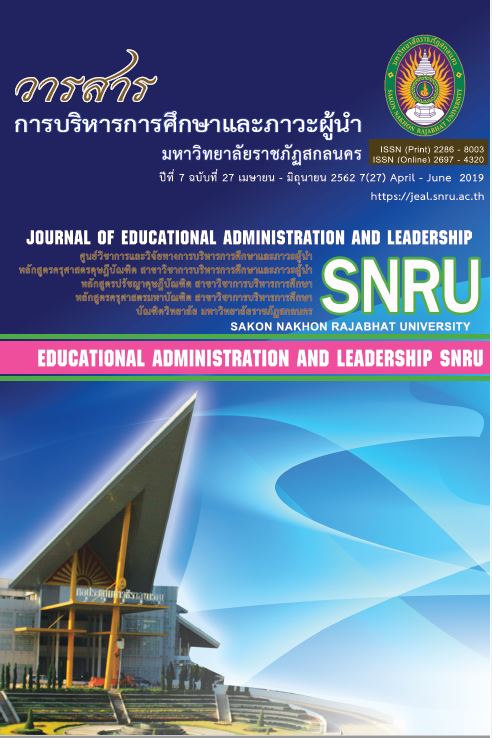

การพัฒนารูปแบบพัฒนาคุณลักษณะอันพึงประสงค์ของนักเรียน ในโรงเรียนประถมศึกษาขนาดเล็ก
The Development of Desirable characteristics Development Model of the Students
ผู้แต่ง
สัมฤทธิ์ สมนาม
บทคัดย่อ
บทคัดย่อ
การวิจัยครั้งนี้มีวัตถุประสงค์เพื่อ 1) เพื่อศึกษาสภาพปัจจุบันและสภาพที่พึงประสงค์ในการพัฒนาคุณลักษณะอันพึงประสงค์ของนักเรียนในโรงเรียนประถมศึกษาขนาดเล็ก
2) เพื่อพัฒนารูปแบบพัฒนาคุณลักษณะอันพึงประสงค์ของนักเรียนในโรงเรียนประถมศึกษาขนาดเล็ก 3) เพื่อศึกษาการใช้รูปแบบพัฒนาคุณลักษณะอันพึงประสงค์ของนักเรียนในโรงเรียนประถมศึกษาขนาดเล็ก และกระบวนการวิจัยจำแนกออกเป็น 3 ระยะ ได้แก่ ระยะที่ 1 ศึกษาสภาพปัจจุบัน และสภาพที่พึงประสงค์ในการพัฒนาคุณลักษณะอันพึงประสงค์ของนักเรียนในโรงเรียนประถมศึกษาขนาดเล็ก ระยะที่ 2 ออกแบบรูปแบบพัฒนาคุณลักษณะอันพึงประสงค์ของนักเรียนในโรงเรียนประถมศึกษาขนาดเล็ก ระยะที่ 3 ศึกษาการใช้รูปแบบพัฒนาคุณลักษณะอันพึงประสงค์ของนักเรียนในโรงเรียนประถมศึกษาขนาดเล็ก เครื่องมือที่ใช้ในการเก็บรวบรวมข้อมูล ได้แก่ แบบสอบถาม แบบประเมิน แบบสัมภาษณ์ สถิติที่ใช้ในการวิเคราะห์ข้อมูล ได้แก่ ค่าเฉลี่ย ส่วนเบี่ยงเบนมาตรฐาน ค่าร้อยละ และการวิเคราะห์เนื้อหา
ผลการวิจัย พบว่า
1. สภาพปัจจุบันของนักเรียนในโรงเรียนประถมศึกษาขนาดเล็ก พบว่า นักเรียนในโรงเรียนประถมศึกษาขนาดเล็ก ส่วนใหญ่สภาพครอบครัวเป็นครอบครัวที่มีฐานะค่อนข้างยากจน ครอบครัวมีรายได้น้อย นักเรียนไม่ได้อยู่กับบิดา มารดา ส่วนใหญ่จะอยู่กับ ปู่ ย่า ตา ยาย หรือญาติ ทำให้นักเรียนไม่ได้รับการอบรมดูแลเอาใจใส่เท่าที่ควร ความเป็นอยู่จึงไม่ค่อยดี ผู้ปกครองไม่ส่งเสริมให้เรียนหนังสือ จึงทำให้นักเรียนขาดความอบอุ่น จิตใจกระด้าง เห็นแก่ตัว ไม่ไว้ใจใคร ขาดความมั่นใจในตนเอง มั่วสุมกับเกม ยาเสพติด อบายมุข ลักขโมย ชอบทำลายของส่วนรวม ไม่มีระเบียบวินัย ขาดความรับผิดชอบ ในเรื่องของการอบรมดูแลความประพฤติผู้ปกครองส่วนใหญ่จะโยนภาระทั้งหมดมาให้โรงเรียนและครูผู้สอนเป็นผู้รับผิดชอบในการอบรมดูแลความประพฤติของนักเรียน ดังนั้น จากการศึกษาสภาพที่พึงประสงค์ โรงเรียนและผู้ปกครองมีความต้องการให้นักเรียนมีการพัฒนาด้านคุณลักษณะอันพึงประสงค์ที่ดีขึ้นให้อยู่ในระดับมาก
ถึงมากที่สุด
2. รูปแบบพัฒนาคุณลักษณะอันพึงประสงค์ของนักเรียนในโรงเรียนประถมศึกษาขนาดเล็กมีความเหมาะสมและครอบคลุมคุณลักษณะอันพึงประสงค์ทั้ง 8 ประการของสำนักงานคณะกรรมการการศึกษาขั้นพื้นฐาน ประกอบด้วยกิจกรรมในการพัฒนา จำนวน 15 กิจกรรม ได้แก่ 1) กิจกรรมหน้าเสาธง 2) กิจกรรมนั่งสมาธิก่อนเข้าเรียน 3) กิจกรรมฟังธรรมทุกวันศุกร์
4) กิจกรรมวันสำคัญต่างๆ 5) กิจกรรมเขตพื้นที่รับผิดชอบ 6) กิจกรรมบันทึกความดี 7) กิจกรรมนักเรียนประพฤติดี 8) กิจกรรมเสริมสร้างระเบียบวินัย 9) กิจกรรมนักเรียนรู้จักการออม
10) กิจกรรมหารายได้ระหว่างเรียน 11) กิจกรรมจิตอาสาพาน้องทำดี 12) กิจกรรมปลูกและดูแลต้นไม้คนละต้น13) กิจกรรมค่ายวิชาการ 14) กิจกรรมห้องเรียนน่าอยู่ 15) กิจกรรมศึกษาแหล่งเรียนรู้ในชุมชน ทุกกิจกรรมมีความเกี่ยวพันเชื่อมโยงกันและกัน อย่างสมดุลให้เกิดผลตามความต้องการในการพัฒนาคุณลักษณะอันพึงประสงค์ของนักเรียนในโรงเรียนประถมศึกษาขนาดเล็ก ทั้งนี้วงจรคุณภาพของ Deming (PDCA) จะช่วยขับเคลื่อนรูปแบบพัฒนาคุณลักษณะอันพึงประสงค์ของนักเรียนในโรงเรียนประถมศึกษาขนาดเล็ก ทำให้นักเรียนที่ได้รับการพัฒนามีคุณลักษณะอันพึงประสงค์ที่ดีขึ้นตามความคาดหวัง
3. ศึกษาการใช้รูปแบบพัฒนาคุณลักษณะอันพึงประสงค์ของนักเรียนในโรงเรียนประถมศึกษาขนาดเล็ก ปรากฎว่า 3.1) ผลการประเมินคุณลักษณะอันพึงประสงค์ของนักเรียน พบว่า ก่อนนำรูปแบบไปใช้มีผลการประเมินอยู่ในระดับปานกลาง เมื่อนำรูปแบบไปใช้เป็นเวลา 1 ปีการศึกษาทำให้ผลการดำเนินงานพัฒนาขึ้น จนมีผลการประเมินอยู่ในระดับมากถึงมากที่สุด 3.2) ครู ผู้ปกครอง และผู้มีส่วนเกี่ยวข้องมีความพึงพอใจในรูปแบบที่พัฒนาขึ้นอยู่ในระดับมาก
Abstract
ABSTRACT
The purposes of this research were 1) studying the current conditions and the desirable conditions in developing desirable characteristics of the students in the small-sized primary schools 2) develop the model for developing desirable characteristics of the students in the small-sized primary schools and 3) study the use of the model for developing desirable characteristics of the students in the small-sized primary schools. The research process was divided into 3 phases : Phase 1 : studying the current conditions and the desirable conditions in developing desirable characteristics of the students in the small-sized primary schools, Phase 2: designing the development of desirable characteristics of the students in the small-sized primary schools and Phase 3 : studying the use of a model for developing desirable characteristics of the students in the small-sized primary schools. The tools used for data collection were questionnaire, assessment form and interview form. The statistics used in data analysis included mean, deviation standard and percentage.
The results were as follows
1. In terms of the current conditions of the students in the small-sized primary schools, they mostly lived in poor families with low income. The students did not live with parents. Most of them lived with grandparents or relatives, causing the students to not receive training as they should. Their living was not good. The parents did not support their children’s learning. Thus the students did not receive love and warmth, and had merciless heart. They were selfish, not trusting anyone, lacking self-confidence, using drug, playing games and being thieves. They also liked to destroy the public facilities and had no discipline and lacked of responsibility. In regard to behavioral training, most parents threw all the burden on the school and the teachers. Therefore, based on the study of the desirable conditions, the school and the parents needed the students to develop the desirable characteristics at a high level to the highest level. ( = 3.79–4.53, S.D. = 0.61–0.87)
2. The model for the development of desirable characteristics of the students in the small-sized primary schools was appropriate and covered all 8 desirable characteristics set by the Office of the Basic Education Commission, consisting of 15 development activities, including 1) the activity in front the flag poles, 2) the meditation activity before starting the class, 3) the activity of listening to Dharma every Friday, 4) the activity on the important days, 5) the activity in the area of responsibility, 6) the activity of recording goodness, 7) the activity of well-behaved students, 8) the activities to build discipline, 9) the activity of savings, 10) the activity for earning income during studying, 11) the activity of being volunteers, 12) the activity of tree planting, 13) the activity of academic camping, 14) the activity of livable classroom and 15) the activity of community learning. All activities were related to each other in a balanced manner, resulting in the success based on the need to develop the desirable characteristics of the students in the small-sized primary schools. Also, the Deming Quality Cycle (PDCA) would help drive the development of desirable characteristics of the students in the small-sized primary schools, enabling the students to develop desirable characteristics as expected.
3. The study results of the use of the model for developing desirable characteristics of the students in the small-sized primary schools were as follows. 3.1) The desirable characteristics of the students before implementing the model were at a moderate level. After implementing the model for 1 academic year,
the evaluation results were at a high level to the highest level. ( = 3.81-4.56, S.D. = 0.62-0.85) 3.2) The teachers, the parents and the stakeholders were satisfied with the development at a high level. (
= 4.37, S.D. = 0.78)
คำสำคัญ
รูปแบบ, การพัฒนาคุณลักษณะอันพึงประสงค์ของนักเรียนKeyword
Model, The Desirable characteristics Development of the StudentsNotice: Undefined variable: dataSet in /var/www/html/ArticleView.php on line 116
Notice: Trying to access array offset on value of type null in /var/www/html/ArticleView.php on line 116
บทความทุกบทความเป็นลิขสิทธิ์ของ
Notice: Undefined variable: dataSet in /var/www/html/ArticleView.php on line 116
Notice: Trying to access array offset on value of type null in /var/www/html/ArticleView.php on line 116
เท่านั้น
กำลังออนไลน์: 42
วันนี้: 70
เมื่อวานนี้: 1,919
จำนวนครั้งการเข้าชม: 1,173,359
อาคารบัณฑิตวิทยาลัย ชั้น 2 ตำบลธาตุเชิงชุม อำเภอเมือง จังหวัดสกลนคร 47000
โทร/
แฟกซ์ 0-4297-0093
บรรณาธิการ: รองศาสตราจารย์ ดร.ไชยา ภาวะบุตร
ติดต่อ/สอบถาม: นายธีรเวทย์ เพียรธัญญกรณ์
โทร: 0-4297-0093